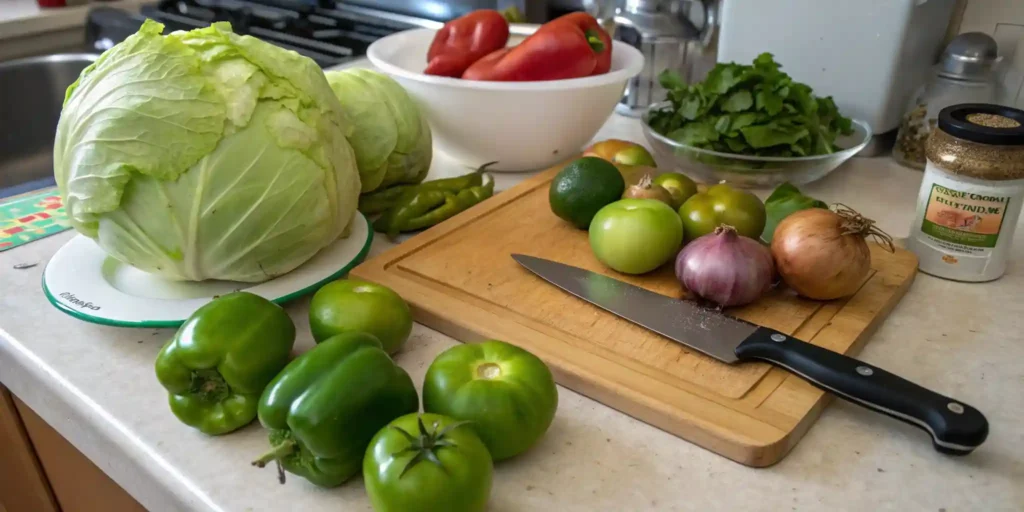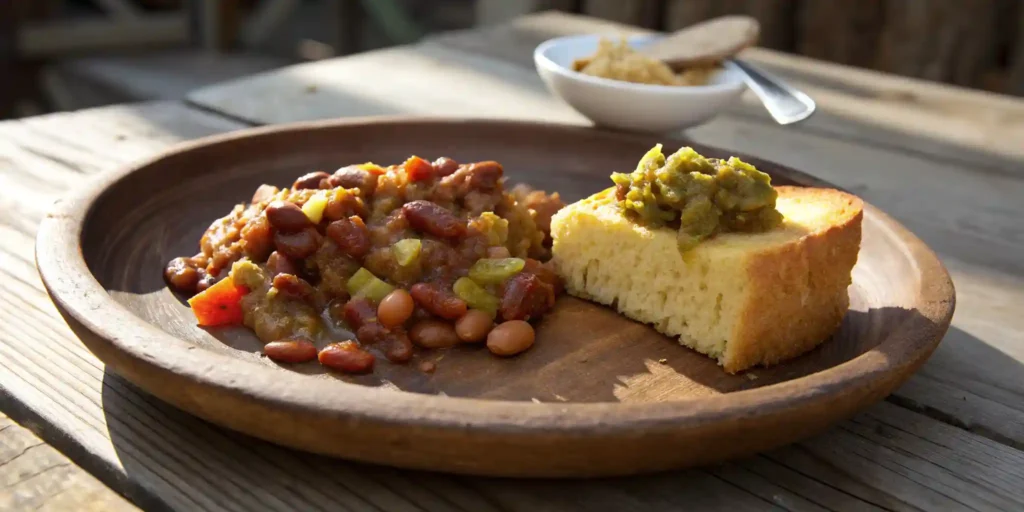What Is Chow Chow?
Chow chow is a versatile and flavorful relish made from a mix of vegetables, spices, and vinegar. This tangy and slightly sweet condiment is a staple in many Southern and Appalachian kitchens, where it’s often used to enhance the flavor of beans, hot dogs, sandwiches, and more. With its vibrant colors and bold taste, chow chow adds a zesty twist to nearly any dish.
Why It’s Popular Across Regions
One of the reasons chow chow remains popular is its adaptability. While the base recipe features vegetables like green tomatoes, cabbage, and peppers, variations abound, allowing cooks to tailor it to their preferences. Whether sweet, spicy, or tangy, this relish captures the essence of home cooking and complements a wide range of meals.
In this article, we’ll explore the history of chow chow, its key ingredients, how it’s made, and the many ways it can be used. Along the way, we’ll also highlight creative variations and answer common questions about this beloved relish. Explore more chow chow recipes.
History of Chow Chow and Ingredients
History of Chow Chow
Origins of This Tangy Relish
Chow chow is believed to have roots in various culinary traditions, including those of Chinese immigrants and European settlers. Although its exact origin is debated, the name “chow chow” likely stems from the Chinese word for “mixed” or “assorted,” reflecting its medley of ingredients. Over time, the recipe was adapted by different cultures, with the Southern United States adopting it as a regional staple.
Regional Variations
In the South, chow chow is typically sweet, tangy, and slightly spicy, with ingredients like green tomatoes and cabbage forming the base. In Pennsylvania Dutch country, however, chow chow leans toward the sweeter side and often incorporates a larger variety of vegetables, including carrots, lima beans, and cauliflower. Regardless of the variation, this relish has remained a beloved way to preserve seasonal produce.
Ingredients

Core Ingredients
The beauty of chow chow lies in its versatility, but most recipes include these staple ingredients:
- Green Tomatoes: A tart and firm base that holds its shape during cooking.
- Cabbage: Adds bulk and crunch to the relish.
- Onions: Contribute sweetness and depth of flavor.
- Peppers: A mix of bell peppers and hot peppers provides both color and heat.
- Vinegar: The acidic component that balances the sweetness and acts as a preservative.
- Sugar: Enhances the sweetness and rounds out the tangy flavors.
- Mustard Seeds: Infuse a subtle, earthy spice.
- Turmeric: Adds a golden hue and a hint of warmth.
Optional Add-Ons for Flavor
To customize chow chow, many cooks experiment with these additional ingredients:
- Carrots: Bring a touch of natural sweetness and a pop of color.
- Cauliflower Florets: Add a slightly nutty flavor and firm texture.
- Celery Seeds: Enhance the relish with a unique aromatic note.
- Jalapeños or Red Chili Flakes: For those who love a spicy kick.
These ingredients can be adjusted based on taste preferences or the vegetables available, much like the flexibility seen in other recipes, such as this cottage cheese recipe collection.
How Chow Chow Is Made
Step-by-Step Preparation
1. Gather and Prep the Vegetables
- Start by washing and chopping the vegetables into small, uniform pieces. Common choices include green tomatoes, cabbage, onions, and peppers. If adding carrots or cauliflower, dice them similarly to ensure even cooking.
- Sprinkle the chopped vegetables with salt and let them sit for a few hours or overnight. This step helps draw out excess moisture, keeping the chow chow crunchy.
2. Create the Spice Mixture
- In a large pot, combine vinegar, sugar, and spices such as mustard seeds, turmeric, and celery seeds. Bring the mixture to a simmer over medium heat, stirring until the sugar dissolves.
3. Cook the Vegetables
- Rinse the salted vegetables thoroughly to remove excess salt. Add them to the pot with the vinegar mixture and stir well.
- Simmer the mixture for 15–20 minutes, stirring occasionally, until the vegetables are tender but still slightly crisp.
4. Jar the Chow Chow
- While the mixture is still hot, transfer it into sterilized jars. Leave about ½ inch of headspace at the top.
- Seal the jars tightly and process them in a water bath canner for 10–15 minutes to ensure proper preservation.
5. Cool and Store
- Let the jars cool completely at room temperature. Once sealed, the chow chow can be stored in a cool, dark place for several months. Allow the flavors to meld for at least a week before opening for the best taste.
Common Mistakes to Avoid
Skipping the Salting Step
Failing to salt the vegetables can result in a watery relish that lacks the desired crunch.
Overcooking the Vegetables
Cooking the vegetables for too long can make the chow chow mushy. To retain some texture, simmer only until they are just tender.
Not Sterilizing the Jars
Sterilized jars are essential for preventing spoilage and ensuring a longer shelf life.
Neglecting to Balance Flavors
Chow chow should strike a harmonious balance between sweet, tangy, and spicy. Taste the mixture before jarring to adjust the seasoning as needed.
By following these steps and avoiding common pitfalls, you’ll create a relish that’s vibrant, flavorful, and perfectly textured.
Uses for Chow Chow and Variations
Popular Dishes That Feature Chow Chow

Classic Pairings
- Beans and Cornbread: A quintessential Southern dish, chow chow’s tangy flavor enhances the heartiness of beans and the sweetness of cornbread.
- Hot Dogs and Burgers: Use chow chow as a zesty alternative to traditional condiments like relish or mustard.
- Pulled Pork Sandwiches: Add a spoonful of chow chow to pulled pork for a bright, tangy contrast to the smoky meat.
Creative Serving Ideas
- Charcuterie Boards: Include a jar of chow chow alongside cheeses, cured meats, and crackers for a unique addition to your spread.
- Tacos or Wraps: Spoon some chow chow onto tacos or wraps for an unexpected burst of flavor.
- Egg Dishes: Pair chow chow with scrambled eggs or an omelet for a savory breakfast option.
Chow chow’s versatility makes it a great way to elevate both traditional and modern dishes, much like other classic recipes, such as this venison chili that benefits from bold, complementary flavors.
Variations of Chow Chow
Sweet vs. Spicy Chow Chow
- For a sweeter chow chow, increase the sugar and reduce the quantity of hot peppers. Adding raisins or dried cranberries can also create a fruity twist.
- To make a spicier version, include jalapeños, red chili flakes, or habaneros for an extra kick. Adjust the spice level to your preference.
Vegan and Gluten-Free Options
- Chow chow is naturally vegan and gluten-free, as it primarily consists of vegetables, vinegar, and spices. To ensure all ingredients are safe, double-check labels on store-bought vinegar and spices.
Pickle-Like Chow Chow
- For a version closer to traditional pickles, use more vinegar and omit the sugar. This creates a tangy, brine-like relish that pairs beautifully with grilled meats and sandwiches.
These variations highlight the adaptability of chow chow, making it easy to customize based on flavor preferences or dietary needs.
Frequently Asked Questions (FAQs)
How Long Does Chow Chow Last?
When properly sealed and stored in sterilized jars, chow chow can last up to a year in a cool, dark place. Once opened, it should be refrigerated and consumed within 4–6 weeks to maintain its freshness and flavor.
Can I Adjust the Spiciness?
Absolutely! Chow chow is highly customizable. To make it spicier, add more hot peppers, red chili flakes, or even cayenne powder. For a milder version, reduce or omit the hot peppers and use sweeter varieties like bell peppers.
What Vegetables Work Best?
The most common vegetables used in chow chow are green tomatoes, cabbage, and onions, but the recipe is flexible. Cauliflower, carrots, green beans, and peppers of all types can also be incorporated. Choose vegetables with a firm texture to ensure they hold up well during cooking.
Is It Different from Piccalilli?
Yes, chow chow and piccalilli are similar but distinct. While both are vegetable-based relishes, piccalilli often has a mustard-forward flavor and a thicker, chutney-like consistency. Chow chow, on the other hand, has a lighter, tangier profile and a looser texture.
How Can I Store It?
Chow chow should be stored in sterilized jars for long-term preservation. If you’re making a smaller batch to consume within a few weeks, you can skip the water bath canning process and refrigerate it immediately. Always ensure jars are sealed properly to prevent spoilage.
